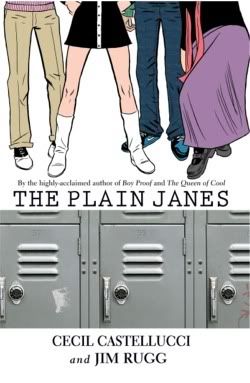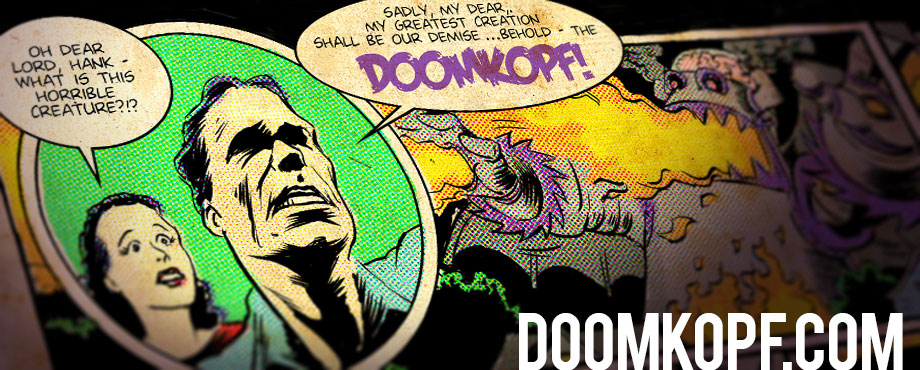Q&A: Cecil Castellucci (PLAIN Janes)
A few months back, I wrote about the debut of DC Comics’ Minx line and the first books. One of those, The PLAIN Janes, I raved about. Recently, I had the luck to talk to the book’s author, Cecil Castellucci, about her first graphic novel, her love of comics and plans for new books.
 Jean-Claude Van Doom:Okay, first, the obvious — what got you interested in comics? Did you read any growing up? If so, what? Do you still read a lot of them?
Jean-Claude Van Doom:Okay, first, the obvious — what got you interested in comics? Did you read any growing up? If so, what? Do you still read a lot of them?
Cecil Castellucci: I did read comics when I was a little girl. I’m French Canadian (but grew up in the States) so my parents got me into Tin Tin, Asterix, Smurfs, Lucky Luke. Also, I was obsessed at a young age with Batman and Superman. Let’s just call them “boyfriends.” Then I also had a little brother who had a fine collection of superhero books. So that’s where I read a lot of Spiderman, Avengers, X-Men, etc. etc. etc. He also got into Vertigo stuff when he was in High School and I was in college. I loved those. Sandman and Animal Man were faves.
Then I was in Montreal, where Drawn and Quarterly is, so I discovered a lot of indie comics, Julie Doucet, Chester Brown, Seth. I loved Roberta Gregory then, too. I wrote her a fan letter when I was 20, and she sent me a Naughty Bits button back. Then I kind of stopped reading because it was too expensive an addiction, and quite honestly I was flat broke. I would occasionally pick some stuff up. And now, happily I’m back reading as much as I can. And am enjoying Fables, Y the Last Man, and all things Superman.
JCVD: How did you get into writing as a career? What made you want to write for a younger audience (I assume that’s not a mischaracterization of your first novels)?
CC: I always wanted to write books and tell stories. I think one of the things about writing for YA is that it is such a compelling time in life. Everything is for the first time. Every feeling runs so high. Every day you are moving from who you were to who you are. It’s like a time where you awaken and I think that is very interesting. That’s why I write for young people.
JCVD: How did the partnership with DC/Minx come about? Had you been interested in doing comics?
CC: I think what happened was that Shelly Bond was starting the Minx line and was looking for some new voices, to see what was out there in people in the YA world who might want to write a graphic novel. She had talked to my friend, an author named Rachel Cohn, who wasn’t interested but passed along my name because Boy Proof (my first novel) is about a girl who reads comic books (a lot of Vertigo ones.) Shelly called and we talked. She had edited one of my favorite series, The Deadenders. We talked and I had been interested in writing comics because I had read that book. I thought it was so YA. I pitched the Janes the first time we talked and then ran with it.
JCVD: Was the idea for PLAIN Janes yours, or did the Minx editorial staff have stories in mind?
CC: PLAIN Janes was totally mine. It had been in my head, this idea about four girls named Jane sitting together at the reject table at lunch, thinking that each day they would get to sit at what they thought was the “cooler” table (ie. the sports table, theater table, science table) and one of the Janes, arty Jane, thought that they were the cool table. The idea just kind of snowballed from there once I started thinking of it as a graphic novel. It was an idea that I couldn’t flesh out into a novel. I thought maybe it would be a cartoon, like an Adult Swim kind of thing. When Shelly Bond told me about the Minx line, it was a natural fit. So, Minx had no stories in mind, and as far as I know, all of the Minx titles spring from the creators.
JCVD: I thought it was an interesting choice to set PLAIN Janes in a very fictional world, i.e. having the generically named major city. It seemed like you wanted to make the story about how people react to tragedy, and there’s obviously an abundance of real life situations that you could’ve used. Why did you think it would be best to use a completely fictional situation, as opposed to 9/11?
CC: Yes. You are correct. I think having it in a fictional situation gives the reader a sort of space between reality. It also gives a chance for me, as a writer, to talk about human things, like fear and tragedy, without having the weight of the reality of our world.
JCVD: One of the things that I really liked about the book was how you left some threads dangling. Particularly, the main Jane’s mother never really reconciled with her fears, and we never see a true conclusion with the John Doe. Is that a way of challenging readers’ expectations?
CC: Yes, I think that things in real life don’t end neatly, and books and stories don’t need to either. Some things are resolved, others aren’t. The hope was to also maybe continue the story, which happily I will. In book two, those things will be addressed and other things will be left dangling.
JCVD: Art obviously plays a huge role in the story. Are you an artist? Can art have as big of an effect on communities as you portrayed in the book?
CC: I have an artists heart, but I am no artist. I wish I was. Art, visual art, street art, every kind of art, moves me. I do think that art can have big effect on communities. Look at Picasso’s Guernica.
JCVD: Something I’ve written about before (and experienced firsthand) is how hard it can be to transition from regular fiction to comics or graphic novels. It’s just a completely different ballgame, and some very good fiction writers have struggled at comics. Was it a challenging jump for you?
CC: It was a very challenging jump because anytime you jump into a new narrative form you’re having to relearn how to tell a story. I think the key thing that I learned is to really trust that you don’t have to explain things with words if it’s already there with the picture. You can take those words out. Go minimal. As a prose writer it’s hard to let go of words, that’s our crutch! But there is also a tremendous freedom from letting go and slashing all those words out. Jim Rugg makes it easy for me to be brave. His art is so beautiful.
JCVD: Probably the aspect of PLAIN Janes that I enjoyed the most was how you let the artist bring across so much of the story, particularly with his expressive characters. How detailed were you in your art direction? How much of what came out in the final product was spontaneous?
CC: I think that Jim and I worked really well together. I gave him some indications. More emotional ones. But I think he also really brought so much to the story with his keen observation of how people really feel. We had a lot of phone meetings where we would talk about the emotional state of the characters. And sometimes, he would suggest a silent beat or something and he was always right. I love listening to what Jim has to say about the story.
JCVD: And, lastly, do you want to keep working in comics? Anything planned? Any dream projects?
CC: I would love to keep working in comics. I ‘m so glad that I am writing book two of the Plain Janes, (Janes in Love). Nothing else is planned but I’d love to try my hand a monthly. And I’d like to also try to play with a superhero. But that’d be totally scary! But fun!
JCVD: Many thanks to Cecil Castellucci!
